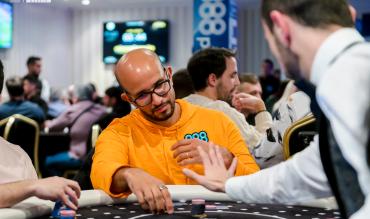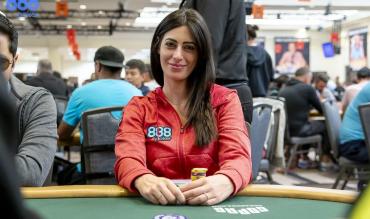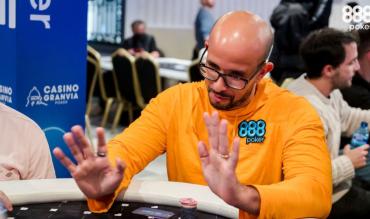If you’re into chess, you’ll know that checking is a pretty powerful play, but it’s not quite as bad-ass in poker.
Why? Let’s take a look.
So, What Is ‘Check’ in Poker
‘What does check mean in poker?’ Checking is the act of not betting when you have the option to do so. It’s not as passive as folding, but it’s not very aggressive either.
It’s like saying ‘no thank you’ when a waiter walks around with a tray of champagne at a posh dinner party.
It’s conservative, but you can always change your mind and take one later.
When Can I Check in Poker
Now that we've answered the question, 'What is check in poker?' it's time to include it in your how to play poker lessons.
Checking is like betting zero, which means you can't do it if someone has already bet on the current street of the hand. For example, if you're in the BB and the SB bets $10 on the flop, you cannot check.
In this case, you can fold, raise or call since continuing already costs more than zero.
If the SB was to check instead, you could check, too, since there would be no bet to call. (You could also bet yourself if you wanted to). If everyone checks, the action moves to the next street, and the dealer will reveal a turn card on the poker board.

Most players aren’t allowed to check preflop either. The big blind works like any other bet, meaning players must either match it or raise if they want to see a flop.
The only time any player gets to check before the flop is when nobody raises. When this happens, the big blind can check (and see a flop) since they have already matched the minimum amount by posting their blind. They also have the option to raise.
| TIP: It's a good idea to watch for players who make mistakes checking, especially if they do so when facing a bet. This tell-tale sign indicates that a player is either new or inattentive and, therefore, a good one to pick on. |
How Do I Check in Live Poker
Checking is pretty straightforward. According to the Tournament Directors Association, ‘tapping the table is a check,’ as is a verbal declaration. But there are also ‘regional terms’ that can be a poker check.
These ‘regional’ gestures come in all shapes and sizes.
- Some players tap the table a couple of times with a finger, and some pat their arm (if they have it crossed, for example).
- Others flamboyantly point to the player to their left or wave their finger like a concert conductor.
- Some players even hold an arm at full stretch and slowly lower it to the table like they were trying not to spook the cards on felt.
Like many things, it’s all about making your intentions clear, but you’ll still see a range of gestures at the table. Sometimes, these will come with a verbal declaration, and other times, they won’t.

However, to avoid mishaps, it's best to accompany the motion you decide to use to check with the poker term ‘check’.
Checking Out of Turn
Checking out of turn is another kind of poker check. It involves checking before the action is on you (like the player on the button checking on the flop before the SB has acted).
This act is mostly a mistake, but repeated checking out of turn is usually punished with a penalty since it can be a form of cheating.
It can give players before you extra information to work with.
Checking out of turn is binding too. Players acting out of turn will be forced to check if no player before them bets.
What Is Checking Back
The term check-back means to check after someone else has already done so. You’ll most commonly hear this phrase when people talk about post-flop hands while in position and debating whether to bet or see another card.
You might hear them say, “My opponent checked the flop, and I checked back”.
Misusing the term is another sign that someone is a weaker player. If they describe a check out-of-position as a “check-back”, for example, you can expect them to make a lot of other mistakes… especially if they say things like “smooth call” or describe Pocket Aces as “bullets”.
What is ‘Checking in the Dark'

Checking in the dark is a common tactic in live poker. It means checking without looking at the board. Like checking out of turn, a check in the dark will be binding, regardless of which card falls.
If another player bets, however, they can call or raise but must check if everyone else does.
You can only check in the dark after the action and would be first to act on the next street. This play has no strategic advantage, which makes the whole thing pointless.
Checking dark is usually an attempt to look cool, a sign of impatience (possibly due to tilt), or trying to psyche out or confuse their opponents.
Though it might seem like a clever trick, professionals don’t tend to check in the dark. They will typically consider how a card changes the board before deciding to bet or not.
With that said, some strong players might still check in the dark if they know they will always check, no matter the next card.
How to Use Checking as Part of Your Poker Strategy

Checking is an excellent way to control the size of the pot. It can be useful when you want to keep the pot small, especially when you are in position.
Players often interpret it as a sign of weakness, which means it can under-represent a strong hand and trick an aggressive opponent into bluffing or being greedy with a medium-strength hand.
Though many players ‘donk-lead’ (betting into a player who was the last aggressor on a previous street), most still habitually check when first to act on the flop.
People make too many continuation bets (betting the flop after raising pre-flop). So, checking allows your opponent to bluff with hands that they would fold if you were to bet.
This checking makes more money when you have a strong poker hand, and they do not.
Strong or Weak - What Does Check Mean in Poker
Though players might check with a strong hand to try to look weak, checking in position often looks weaker. Players with good hands will usually want to build a pot and avoid allowing their opponents to draw them out.
Checking when out of position used to be a sign of weakness in poke. Good table etiquette discouraged players from check-raising (with some casinos banning it altogether). Without checking and then raising, checking was a sign that someone wanted to keep the pot small and, therefore, weak.

However, check-raising is a standard (and potentially powerful) play these days. As a result, a check in poker can be strong or neutral in many situations.
For example, a player opens from the button and the big blind calls and then checks on an A73 flop. The check doesn’t look weak since the BB will likely check this flop regardless of their poker combo.
However, checking when out of position looks much weaker over multiple betting streets, especially if your opponent checked back in the previous street. Your opponent’s passiveness makes it less likely they will bet, so you would likely want to start building a pot with a strong hand.
‘What does check mean in poker?’ is an intricate question to answer.
Like many things in the game, checking is a simple idea that can be difficult to implement. This guide should help you understand the concept and check in poker more effectively.
Good luck!
For a full discussion on the different legal options in poker, see the glossary entry on Actions.


